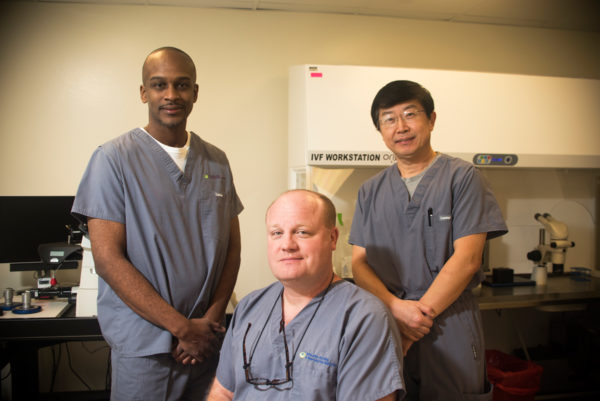Understanding what happens in the IVF lab
While in vitro fertilization (IVF) is well-known as a fertility treatment, many people don’t understand what happens in the IVF lab. We want our patients to feel informed and understand the IVF lab process. Our Shreveport fertility clinic serves the ArkLaTex area, including Texarkana and Southern and South Central Arkansas. We proudly offer the experience of Dr. David Vandermolen, who has spent more than 30 years directing IVF treatment, and a fully accredited, advanced IVF lab to support our patients..
What happens in the IVF lab during fertilization
After eggs have been retrieved from the ovaries, our skilled embryologists will methodically examine them in the lab. Embryologists are highly specialized, with technical knowledge to carefully handle eggs, sperm and embryos. The eggs are carefully counted and examined to determine their maturity level. We encourage patients to understand the IVF process – including both the laboratory and medical components – and we regularly communicate updates.
Along with egg retrieval, sperm are also being collected and readied for fertilization. Sperm can come from a male partner or a trusted sperm bank. Our embryologists consider overall sperm quality to determine the optimal selection for fertilization.
Once the sperm are prepared, there are options for how fertilization will occur.
- Conventional insemination – Sperm and eggs are co-incubated together to fertilize naturally in a petri dish, or.
- Intracytoplasmic sperm injection – An embryologist precisely injects a single sperm into each egg. This can be used in conditions in which the egg might be impenetrable, or if a man has a very low sperm count, low sperm motility (swimming rate), and/or a sperm morphology (shape) issue.
Fertilization is a critical step in what happens in the IVF lab, and our lab team will keep you informed every step of the way.
Embryo development and transfer: understand the IVF lab process
The day after the eggs have been fertilized, our embryologists will examine them to see if the process was successful. If so, the fertilized eggs are now referred to as embryos. The next step of what happens in the IVF lab involves our embryology team closely monitoring embryo development over the next few days.
About five to six days after fertilization, some embryos reach what is called the blastocyst stage, which features a cell-lined, fluid-filled cavity that houses an inner dense collection of the cells, the inner cell mass. This mass develops into the fetus. Blastocysts are graded as to quality, to determine which ones to transfer or freeze.
This blastocyst stage is also when preimplantation genetic testing (PGT) takes place, for those choosing to identify which embryos are chromosomally or genetically healthiest for transfer.
The final step of the IVF cycle is transfer of the selected embryo(s) into the uterus. The timing of the transfer depends on whether it is a fresh transfer (usually three to five days after egg retrieval) or a frozen transfer (done at a later date).
The embryo transfer involves the lab placing the embryos into a thin, flexible catheter, which Dr. Vandermolen then carefully guides through the cervix into the uterus with ultrasound guidance. After the transfer, patience is needed because patients usually wait nine to 11 days before taking a blood pregnancy test.
IVF is complex, yet in some ways quite simple, and we want to demystify what happens in the IVF lab for our patients. If you need more information to help you understand the IVF lab process, contact us for answers and to see how our Shreveport fertility clinic can make your family-building dreams a reality.

